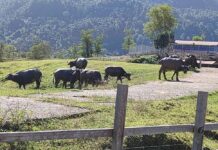THE mustards, broccolis and cab- bages of the world share a distinct and bitter taste. Some consider the flavor of cruciferous plants their strongest attribute. But even in India and China, where Brassicas have been cultivated for more than 4,000 years, scientists have sought to tone down the chemical compounds responsible for their pungent flavor. Turns out the same compounds that make them bitter also make them toxic at some levels.
Now researchers from three continents — including biologists from Washington University in St. Louis — have mapped the crystal structure of a key protein that makes the metabolites responsible for the bitter taste in Brassicas. A study published recently in the journal The Plant Cell is the first snapshot of how the protein evolved and came to churn out such diverse byproducts in this agriculturally significant group of plants.
The results could be used along with ongoing breeding strategies to manipulate crop plants for nutritional and taste benefits.
The new work is born of a longtime collaboration initiated by Naveen C. Bisht, staff scientist at the National Institute of Plant Genome Research, in New Delhi, India, with Joseph Jez, professor of biology in Arts & Sciences at Washington University, and Jonathan Gershenzon, of the Max Planck Institute for Chemical Ecology, in Jena, Germany.
“All of the Brassicas — be it Indian mustard, Arabidopsis, broccoli or brussel sprouts — they all make these pungent, sulphur-smelling compounds, the glucosinolates,” Jez said. The compounds have long been recognised as a natural defense against pests.
“Plants need to fight back,” Jez said. “They can’t really do anything, but they can make stuff.”
“There’s different profiles of glucosinolates in different plants,” he said. “The question has always been if you could modify their patterns to make something new. If insects are eating your plants, could you change the profile and get something that could prevent crop loss?”
But there are a daunting number of glucosinolates: almost 130 different kinds recognised within the Brassicas. Each plant species within the genus makes a “collection” of several different kinds of glucosinolates—its own flavor mix—all of which are secondary metabolites of a particular protein.
Researchers have known about the central role of this protein for decades. But prior to this study, no one had ever been able to complete the x-ray crystallography necessary to map it in detail.
The new work, co-led by Roshan Kumar, now a postdoctoral fellow in the Jez laboratory at Washington University, uses genetics, biochemistry and structural biology to help unravel the molecular basis for the evolution and diversification of glucosinolates.
















